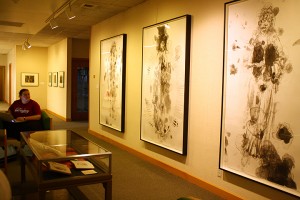By Elise Gallant
Any student who’s recently been down to Burling’s basement has probably noticed the three impressive portraits of “Foolish Virgins” by Diane Victor hanging on the south wall. These are just a few pieces in the current exhibition “Women in Conflict,” curated by student interns Caitilin Hawley ’11 and Maya Ruiz-Stanbary ’11.

Hawley and Ruiz-Stanbary wanted to show a progression of how depictions of the female form changed through time. In the explanatory text posted on the wall, they describe the visual differences that appear through these transitions.
“The creative objectives of artists depicting [women in conflict] have undergone a subtle but significant shift,” one text reads. “That is, a shift from using women’s bodies to emphasize the horror of violent situation … to using the female form to provoke dialogue on contemporary social issues.”
In order to present the changes, Hawley and Ruiz-Stanbary drew a diverse array of art from the College’s collections.
The selections include a series of William Hogarth’s plates from “A Harlot’s Progress,” completed in 1743. These depict a Victorian young lady, lured into the seedy underbelly of society, whose life falls to shambles as a consequence.
One particularly evocative print shows the harlot upending a table while aristocratic tea-drinkers and a black servant look on in astonishment. The series ends with a depiction of the harlot’s coffin, on which her mourners have placed a glass of wine.
Most of the exhibit is located in the main hallway of the basement, but some pieces are hung in the print study room. A group of shocking prints from Goya’s “Disasters of War” (1810-20) series confronts anyone walking in the door.
Hawley and Ruiz-Stanbary were initially inspired by Goya’s pieces and knew that they wanted to incorporate some of his prints into the show.
“Goya effectively emphasizes the horror of war by juxtaposing it with the innocence and virtue associated with femininity,” Hawley and Ruiz-Stanbary wrote in an email.
Indeed, the women in Goya’s prints look serene or unconscious, as if they are martyrs or saints, so the viewer will sympathize with them and wish to remove from their terrible environments.
Goya’s depiction of women greatly contrasts Diane Victor’s, even though they both appeal to women’s spirituality.
Victor’s triptych “The Wise and Foolish Virgins” of Mary, Catherine and Agatha is crafted in charcoal, but Victor incorporated abstract stained shapes into the women’s bodies. These distortions remove the women’s innocence whereas Goya accentuated it.
“The Wise and Foolish Virgins” were an unexpected enhancement to Hawley and Ruiz-Stanbary’s exhibit.
“They were last minute additions to our checklist but we feel like their strong presence really helped to transform the space and unify our show,” Hawley and Ruiz-Stanbary wrote.
Diane Victor lent two other pieces to the exhibit, “Apollo and Daphne” (2009) and “The Death of Adonis” (2010) from Victor’s series “The Birth of a Nation.” These two paintings contextualize women’s struggles within the social conditions of South Africa, reflecting the focus of Victor’s previous exhibit in Faulconer.
Through the collection, Hawley and Ruiz-Stanbary succeed in demonstrating the development of representations of the female form.
Comparing Victor’s distorted figures to Goya’s idealized ones shows that even though the war is over, women are still captured in enemy territory— there is still work need to be done to prevent injustices against women.




























































